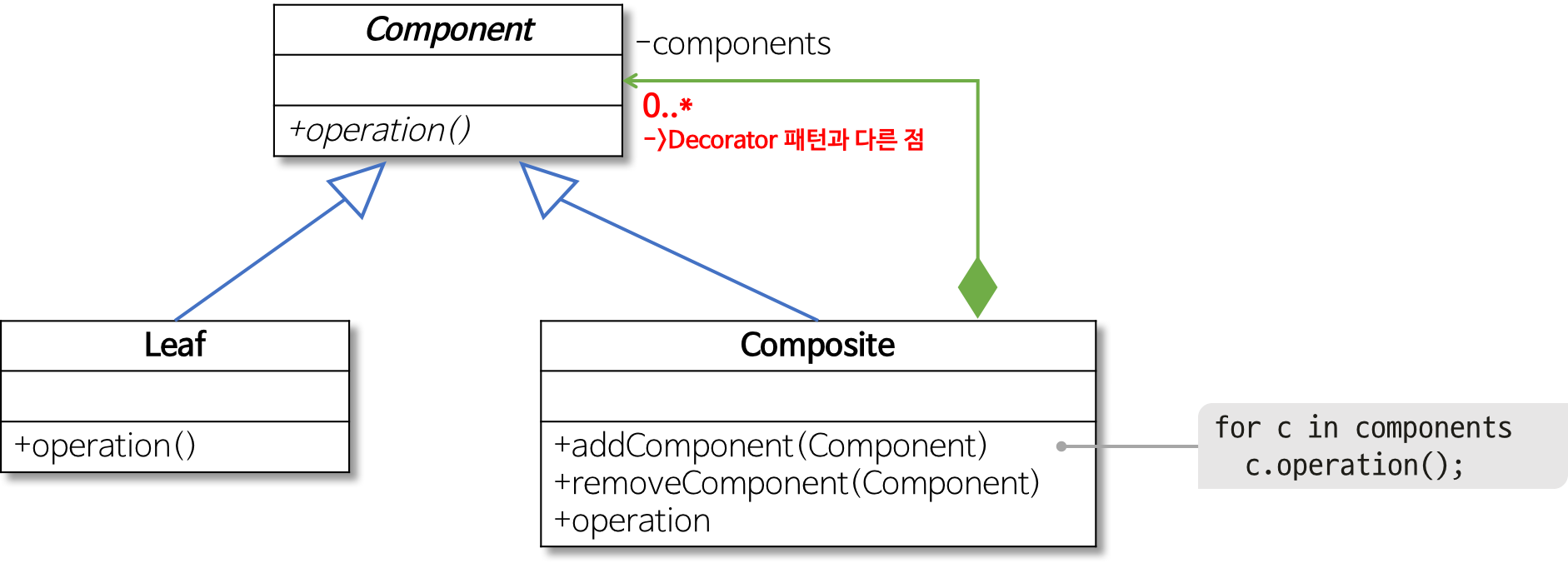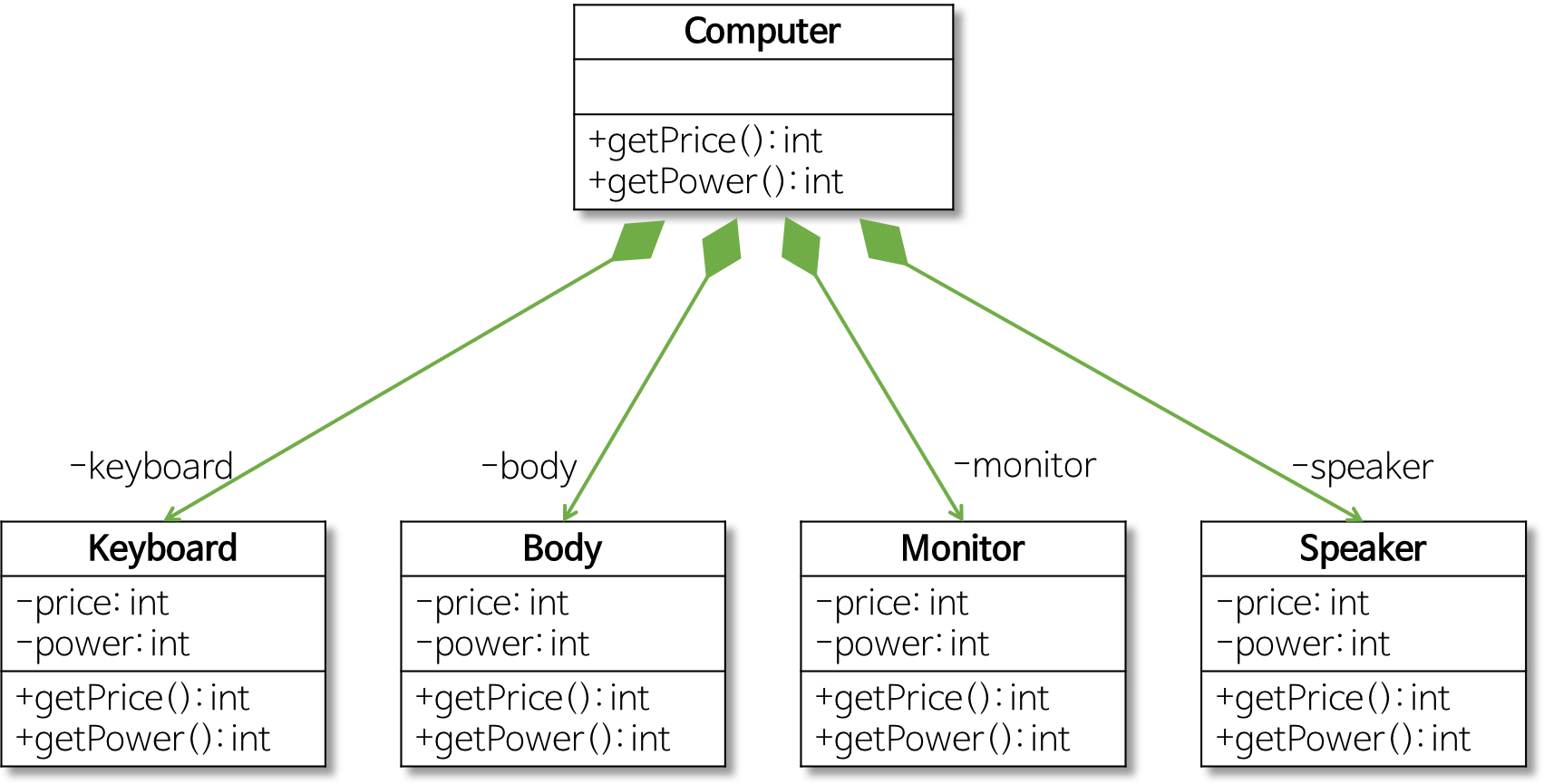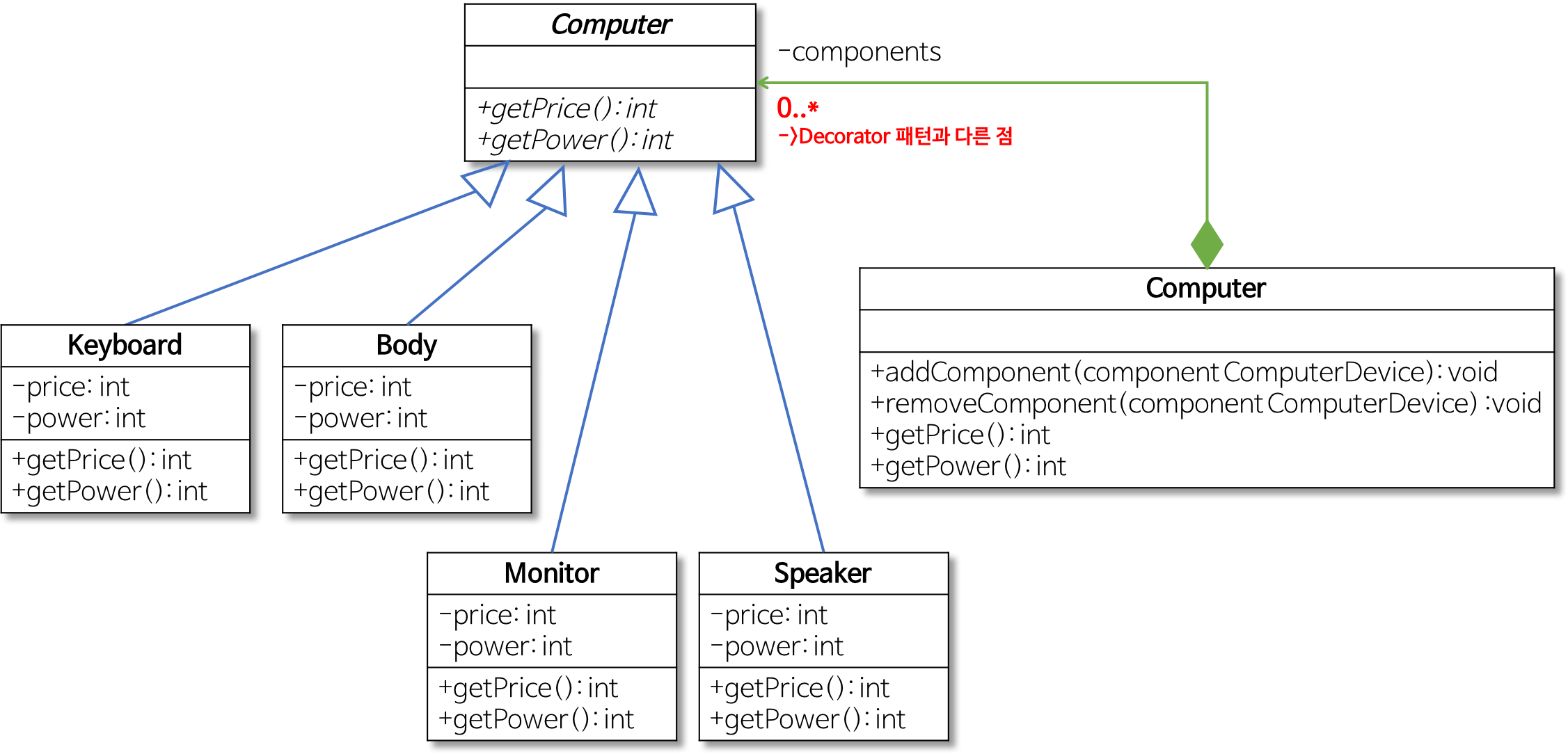
Goal
- 컴퍼지트 패턴의 개념을 이해한다.
- 예시를 통해 컴퍼지트 패턴을 이해한다.
컴퍼지트 패턴이란
- 여러 개의 객체들로 구성된 복합 객체와 단일 객체를 클라이언트에서 구별 없이 다루게 해주는 패턴
- 즉, 전체-부분의 관계(Ex. Directory-File)를 갖는 객체들 사이의 관계를 정의할 때 유용하다.
- 또한 클라이언트는 전체와 부분을 구분하지 않고 동일한 인터페이스 를 사용할 수 있다.
- ‘구조(Structural)’의 하나 (아래 참고)

- 역할이 수행하는 작업
- Component
- 구체적인 부분
- 즉 Leaf 클래스와 전체에 해당하는 Composite 클래스에 공통 인터페이스를 정의
- Leaf
- 구체적인 부분 클래스
- Composite 객체의 부품으로 설정
- Composite
- 전체 클래스
- 복수 개의 Component를 갖도록 정의
- 그러므로 복수 개의 Leaf, 심지어 복수 개의 Composite 객체를 부분으로 가질 수 있음
- Component
참고
- 구조(Structural) 패턴
- 클래스나 객체를 조합해 더 큰 구조를 만드는 패턴
- 예를 들어 서로 다른 인터페이스를 지닌 2개의 객체를 묶어 단일 인터페이스를 제공하거나 객체들을 서로 묶어 새로운 기능을 제공하는 패턴이다.
예시
컴퓨터에 추가 장치 지원하기

- 컴퓨터(Computer 클래스) 모델링
- 키보드(Keyboard 클래스): 데이터를 입력받는다.
- 본체(Body 클래스): 데이터를 처리한다.
- 모니터(Monitor 클래스): 처리 결과를 출력한다.
- Computer 클래스 –‘합성 관계’– 구성 장치
참고
- 합성 관계
- 생성자에서 필드에 대한 객체를 생성하는 경우
- 전체 객체의 라이프타임과 부분 객체의 라이프 타임은 의존적이다.
- 즉, 전체 객체(마름모가 표시된 클래스)가 없어지면 부분 객체도 없어진다.
public class Keyboard {
private int price;
private int power;
public Keyboard(int power, int price) {
this.power = power;
this.price = price;
}
public int getPrice() { return price; }
public int getPower() { return power; }
}
public class Body { 동일한 구조 }
public class Monitor { 동일한 구조 }
public class Computer {
private Keyboard Keyboard;
private Body body;
private Monitor monitor;
public addKeyboard(Keyboard keyboard) { this.keyboard = keyboard; }
public addBody(Body body) { this.body = body; }
public addMonitor(Monitor monitor) { this.monitor = monitor; }
public int getPrice() {
int keyboardPrice = keyboard.getPrice();
int bodyPrice = body.getPrice();
int monitorPrice = monitor.getPrice();
return keyboardPrice + bodyPrice + monitorPrice;
}
public int getPower() {
int keyboardPower = keyboard.getPower();
int bodyPower = body.getPower();
int monitorPower = monitor.getPower();
return keyboardPower + bodyPower + monitorPower;
}
}
public class Client {
public static void main(String[] args) {
// 컴퓨터의 부품으로 Keyboard, Body, Monitor 객체를 생성
Keyboard keyboard = new Keyboard(5, 2);
Body body = new Body(100, 70);
Monitor monitor = new Monitor(20, 30);
// Computer 객체를 생성하고 부품 객체들을 설정
Computer computer = new Computer();
computer.addKeyboard(keyboard);
computer.addBody(body);
computer.addMonitor(monitor);
// 컴퓨터의 가격과 전력 소비량을 구함
int computerPrice = computer.getPrice();
int computerPower = computer.getPower();
System.out.println("Computer Price: " + computerPrice + "만원");
System.out.println("Computer Power: " + computerPower + "W");
}
}
[출력 결과]
Computer Price: 102만원
Computer Power: 120W
문제점
- 다른 부품이 추가되는 경우
- Computer 클래스의 부품으로 Speaker 클래스 또는 Mouse 클래스를 추가한다면?

public class Speaker {
private int price;
private int power;
public Speaker(int power, int price) {
this.power = power;
this.price = price;
}
public int getPrice() { return price; }
public int getPower() { return power; }
}
public class Computer {
. . .
private Speaker speaker; // 추가
. . .
public addMonitor(Monitor monitor) { this.monitor = monitor; } // 추가
public int getPrice() {
. . .
int speakerPrice = speaker.getPrice(); // 추가
return keyboardPrice + bodyPrice + monitorPrice + speakerPrice;
}
public int getPower() {
. . .
int speakerPower = speaker.getPower(); // 추가
return keyboardPower + bodyPower + monitorPower + speakerPower;
}
}
- 위와 같은 방식의 설계는 확장성이 좋지 않다. 즉, OCP를 만족하지 않는다.
- 새로운 부품을 추가할 때마다 Computer 클래스를 아래와 같이 수정해야 한다.
- 새로운 부품에 대한 참조를 필드로 추가한다.
- 새로운 부품 객체를 설정하는 setter 메서드로 addDevice와 같은 메서드를 추가한다.
- getPrice, getPower 등과 같이 컴퓨터의 부품을 이용하는 모든 메서드에서는 새롭게 추가된 부품 객체를 이용할 수 있도록 수정한다.
- 문제점의 핵심은 Computer 클래스에 속한 부품의 구체적인 객체를 가리키면 OCP를 위반하게 된다는 것이다.
해결책
구체적인 부품들을 일반화한 클래스를 정의하고 이를 Computer 클래스가 가리키도록 설계한다.

- 구체적인 부품들을 일반화한 ComputerDevice 클래스를 정의
- ComputerDevice 클래스는 구체적인 부품 클래스의 공통 기능만 가지며 실제로 존재하는 구체적인 부품이 될 수는 없다. (즉, ComputerDevice 객체를 실제로 생성할 수 없다.)
- 그러므로 ComputerDevice 클래스는 추상 클래스가 된다.
- 구체적인 부품 클래스들(Keyboard, Body 등)은 ComputerDevice의 하위 클래스로 정의
- Computer 클래스는 복수 개( 0..* )의 ComputerDevice 객체를 갖음
- Computer 클래스도 ComputerDevice 클래스의 하위 클래스로 정의
- 즉, Computer 클래스도 ComputerDevice 클래스의 일종
- ComputerDevice 클래스를 이용하면 Client 프로그램은 Keyboard, Body 등과 마찬가지로 Computer를 상용할 수 있다.
public abstract class ComputerDevice {
public abstract int getPrice();
public abstract int getPower();
}
public class Keyboard extends ComputerDevice {
private int price;
private int power;
public Keyboard(int power, int price) {
this.power = power;
this.price = price;
}
public int getPrice() { return price; }
public int getPower() { return power; }
}
public class Body { 동일한 구조 }
public class Monitor { 동일한 구조 }
public class Computer extends ComputerDevice {
// 복수 개의 ComputerDevice 객체를 가리킴
private List<ComputerDevice> components = new ArrayList<ComputerDevice>();
// ComputerDevice 객체를 Computer 클래스에 추가
public addComponent(ComputerDevice component) { components.add(component); }
// ComputerDevice 객체를 Computer 클래스에서 제거
public removeComponent(ComputerDevice component) { components.remove(component); }
// 전체 가격을 포함하는 각 부품의 가격을 합산
public int getPrice() {
int price = 0;
for(ComputerDevice component : components) {
price += component.getPrice();
}
return price;
}
// 전체 소비 전력량을 포함하는 각 부품의 소비 전력량을 합산
public int getPower() {
int power = 0;
for(ComputerDevice component : components) {
price += component.getPower();
}
return power;
}
}
public class Client {
public static void main(String[] args) {
// 컴퓨터의 부품으로 Keyboard, Body, Monitor 객체를 생성
Keyboard keyboard = new Keyboard(5, 2);
Body body = new Body(100, 70);
Monitor monitor = new Monitor(20, 30);
// Computer 객체를 생성하고 addComponent()를 통해 부품 객체들을 설정
Computer computer = new Computer();
computer.addComponent(keyboard);
computer.addComponent(body);
computer.addComponent(monitor);
// 컴퓨터의 가격과 전력 소비량을 구함
int computerPrice = computer.getPrice();
int computerPower = computer.getPower();
System.out.println("Computer Price: " + computerPrice + "만원");
System.out.println("Computer Power: " + computerPower + "W");
}
}
- Computer 클래스
- ComputerDevice의 하위 클래스면서 복수 개의 ComputerDevice를 갖도록 설계했다.
- addComponent() 메서드를 통해 구체적인 부품인 Keyboard, Body 등을 Computer 클래스의 부품으로 설정했다.
- Client
- addComponent() 메서드를 통해 부품 종류에 관계 없이 동일한 메서드로 부품을 추가할 수 있다.
- 이제, Computer 클래스는 OCP를 준수 한다.
- 새로운 부품을 추가한다면 ComputerDevice 클래스의 하위 클래스로 구현하면 된다.
- 컴퍼지트 패턴을 이용하면 부분 객체의 추가나 삭제 등이 있어도 전체 객체의 클래스 코드를 변경하지 않아도 된다.
- 즉, 전체-부분 관계(Ex. Directory-File)를 갖는 객체들 사이의 관계를 정의할 때 유용하다.

- “Component”: ComputerDevice 클래스
- “Leaf”: Keyboard 클래스, Body 클래스, Monitor 클래스, Speaker 클래스
- “Composite”: Computer 클래스
- 스트래티지(Strategy) 패턴에 대해 알고 싶으시면 스트래티지(Strategy) 패턴을 참고하시기 바랍니다.
- 싱글턴(Singleton) 패턴에 대해 알고 싶으시면 싱글턴(Singleton) 패턴을 참고하시기 바랍니다.
- 커맨드(Command) 패턴에 대해 알고 싶으시면 커맨드(Command) 패턴을 참고하시기 바랍니다.
- 옵저버(Observer) 패턴에 대해 알고 싶으시면 옵저버(Observer) 패턴을 참고하시기 바랍니다.
- 데코레이터(Decorator) 패턴에 대해 알고 싶으시면 데코레이터(Decorator) 패턴을 참고하시기 바랍니다.
- 템플릿 메서드(Template Method) 패턴에 대해 알고 싶으시면 템플릿 메서드(Template Method) 패턴을 참고하시기 바랍니다.
- 팩토리 메서드(Factory Method) 패턴에 대해 알고 싶으시면 팩토리 메서드(Factory Method) 패턴을 참고하시기 바랍니다.
- 추상 팩토리(Abstract Factory) 패턴에 대해 알고 싶으시면 추상 팩토리(Abstract Factory) 패턴을 참고하시기 바랍니다.




近期评论